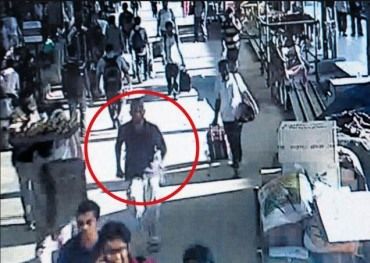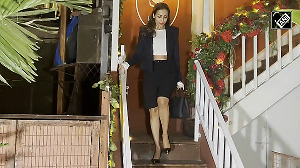 Only 40 of the 100 CCTV cameras at the Bangalore railway station, from where the suspected bomber boarded the Bangalore-Guwahati Express, are functional.
Only 40 of the 100 CCTV cameras at the Bangalore railway station, from where the suspected bomber boarded the Bangalore-Guwahati Express, are functional.
Further investigation into Thursday's low-intensity blasts expose loopholes in security arrangements at Bangalore and Chennai train stations. Vicky Nanjappa reports.
The CCTV footage at the Chennai Central Railway Station shows a middle-aged man, whose face was covered with a handkerchief, running towards the exit minutes before twin bombs went off in two coaches on the Bangalore-Guwahati Express on last Thursday. The footage, though blurry, is being looked at as the first lead in the investigation. So what are the chances of the police nabbing the suspect on the basis of this evidence?
Last month, at the Bangalore railway station, where the Chennai bomber boarded the train, a man managed to unscrew five public display units and make an escape without catching the attention of security forces -- all in broad daylight.
On realising that the LED units were missing, the police checked the CCTV only to find a “ghost-like figure” carrying them on his head and fleeing. The image was so hazy that only the outline of the thief could be seen. It prompted a police officer to joke, “I think there is a ghost at the railway station.”
The case of the Chennai blast investigation is similar. The CCTV image shows a similar ghost-like figure. The images captured at the Bangalore and Chennai railways stations are hazy. This initial clue and the pathetic security arrangements at the railway stations have left investigators groping in the dark.
The suspect boarded the train from Bangalore, but the police are not sure if he entered the station with a bomb. Of the 100 CCTVs installed at the station only 40 are functional. Initially there were 40 CCTVs installed, but after the LED robbery the railway board approved the installation of 60 more.
Ironically, the new cameras have not been connected to the control room, which was been set up on platform number 5. This practically makes them useless, an investigator told rediff.com.
The metal detectors are also of no help. The Bangalore station has two-door frame metal detectors, which are not working. This means the Railway Police Force relies on hand detectors. It is a cumbersome job and in the bargain 60 per cent of the passengers are not checked.
Moreover, these devices fail to detect IEDs. And with no woman police officers, woman passengers go unchecked.
Both the Chennai and Bangalore railway stations have six entry points. But there are 20 other ways to enter the stations, which are not manned by security guards.
Railway sources told rediff.com that funds were allocated to block these illegal entry points a year ago. But the work has not even started and the money is untraceable.
“The poor security at Bangalore and Chennai railway stations cause hurdles in the investigation. We are left chasing theories,” a police officer said.
The bombs used in the train blast had similar composition to explosives used by the Indian Mujhadieen. However, the terror group does not have much presence in Chennai. It is being investigated if Tamil Nadu-based Al-Ummah had a role to play in the blasts, investigators revealed.
The other angle, which the police are investigation, is whether Thursday’s bombings were a dry run by the Inter-Services Intelligence-sponsored Sri Lankan extremists. Chennai is an important destination for the ISI. Both Chinese and the Pakistani smugglers use the sea route in Tamil Nadu to push arms into south India. But will they put agencies on alert with such a minor attack under the guise of calling it a dry run. Even investigators wonder.
Image: The blur CCTV footage of the suspected bomber in the Bangalore-Guwahati Express blasts











 © 2025 Rediff.com -
© 2025 Rediff.com -